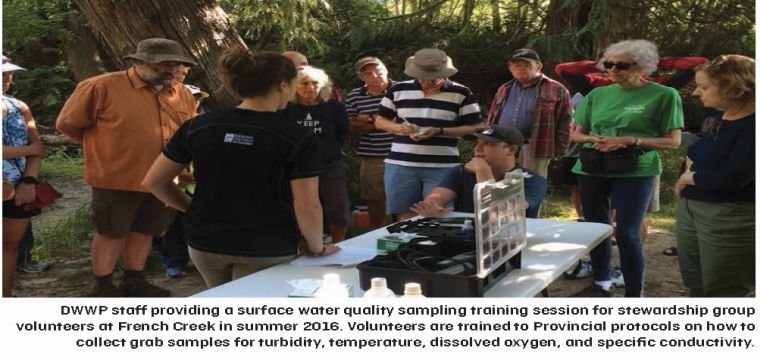Drinking Water & Watershed Protection in the Regional District of Nanaimo: “The program is well positioned, with a model of innovative collaboration, to tackle the issues and chart a new course to a sustainable water future,” stated Julie Pisani, DWWP Program Coordinator
Note to Reader:
The rhythms of water are changing in British Columbia – winters are wetter and warmer; summers are longer and drier. In short, the water cycle is out of balance. Adapting to climate change requires transformation in how we perceive watershed worth and service land.
The Nanaimo Water Symposium on April 11-12, 2018 is designed to foster a conversation in the mid-Vancouver Island region and beyond about the transformational scope of the “Sustainable Watershed Systems, through Asset Management” program.
The Symposium is an opportunity for attendees to learn about the over-arching role played by the innovative and precedent-setting Drinking Water & Watershed Protection Program in the Regional District of Nanaimo. 2018 marks the tenth year of the DWWP program implementation. An Action Plan update will outline the priority actions and mandate for the next 10 years.

Sustainable Partnerships in the Regional District of Nanaimo (RDN)
he Regional District of Nanaimo (RDN) spans an area over 2,000 square km on the east coast of Vancouver Island from Deep Bay in the north to Yellow Point in the south.
The watersheds in the region are defined by short distances from mountain top to sea, with active forestry in the upper watersheds, productive agricultural lands in the middle watersheds, and growing urban and rural communities in the lower watersheds.
The land base is marked by some larger rivers and many smaller fish-bearing creeks. Drinking water for the region’s communities comes from a number of complex groundwater sources and a few surface water sources.
A Coordinated Response to Unknowns and Changes
 “Like other locations in the province, the region is experiencing change: population growth as more residents are attracted to the area; climate change that manifests as longer, drier summers and more frequent short-duration intense rainstorms; and an evolving regulatory landscape that opens up possibilities for local water management,” explains Julie Pisani, Program Coordinator for the Drinking Water & Watershed Protection (DWWP) program in the RDN.
“Like other locations in the province, the region is experiencing change: population growth as more residents are attracted to the area; climate change that manifests as longer, drier summers and more frequent short-duration intense rainstorms; and an evolving regulatory landscape that opens up possibilities for local water management,” explains Julie Pisani, Program Coordinator for the Drinking Water & Watershed Protection (DWWP) program in the RDN.
“What sets RDN apart is that in the face of unknowns and changes that can affect water resources, they are at the helm, actively steering to a sustainable and well-informed future. Their long-term innovative regional program to protect water resources recognizes watersheds as the best management unit and enables collaborative initiatives, including community participation in water monitoring and water conservation.”

A Look Back
In 2008, and as the outcome of a successful referendum, the Regional District of Nanaimo (RDN) was the first regional government to create a Drinking Water and Watershed Protection (DWWP) service with taxation authority.
 “Collaboration underscores the success of the RDN’s innovative program. It is charting a new course to a sustainable water future,” notes John Finnie, the RDN’s former General Manager of Regional & Community Utilities. He is the Chair, Nanaimo Symposium Organizing Committee. ”The 2008 referendum was the culmination of a 6-year effort. In 2012, the service area was expanded to include the municipalities within the regional district and they became active participants in the watershed function.”
“Collaboration underscores the success of the RDN’s innovative program. It is charting a new course to a sustainable water future,” notes John Finnie, the RDN’s former General Manager of Regional & Community Utilities. He is the Chair, Nanaimo Symposium Organizing Committee. ”The 2008 referendum was the culmination of a 6-year effort. In 2012, the service area was expanded to include the municipalities within the regional district and they became active participants in the watershed function.”
 “Over a decade ago, a growing population combined with known negative impacts created the need to tackle issues of groundwater depletion, stream degradation, surface water contamination and the changes climate change will bring. The Regional Board of the day understood that land use planning and development standards cannot be effectively modified without a clear understanding of our water resources, where they are changing and why,” continues Mike Donnelly, former RDN Manager of Water Services.
“Over a decade ago, a growing population combined with known negative impacts created the need to tackle issues of groundwater depletion, stream degradation, surface water contamination and the changes climate change will bring. The Regional Board of the day understood that land use planning and development standards cannot be effectively modified without a clear understanding of our water resources, where they are changing and why,” continues Mike Donnelly, former RDN Manager of Water Services.
Moving Forward
“Science and data collection are key focuses of the program,” reports Julie Pisani. “The DWWP program’s success is based on staying on course with reliable ongoing funding, collaborative fact-finding and project implementation, and recognition-in-action that watersheds don’t conform to jurisdictional boundaries. However, there is still a lot of work to be done to adapt to a changing climate.
“2018 marks the tenth year of the DWWP program implementation and an Action Plan update will outline the priority actions and mandate for the next 10 years. The solid foundation developed in the first 10 years provides a great opportunity to move forward with gained insight, practical understanding of the mechanics of program implementation, and context for the tools available through the new BC Water Sustainability Act.
“The RDN DWWP program is well positioned, with a model of innovative collaboration, to tackle the issues and chart a new course to a sustainable water future. Will other regions take notice and follow in RDN’s footsteps?”
To Learn More:
Download a PDF copy of Charting a New Course to a Sustainable Water Future, an article co-authored by Julie Pisani and Pat Lapcevic on the RDN’s Drinking Water and Watershed Protection program, and published in the January/February 2018 issue of Innovation Magazine.


